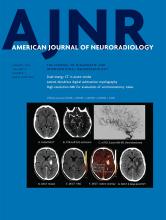Index by author
Abdulla, S.
- Adult BrainYou have accessDecreased Subcortical T2 FLAIR Signal Associated with SeizuresP. Nicholson, S. Abdulla, L. Alshafai, D.M. Mandell and T. KringsAmerican Journal of Neuroradiology January 2020, 41 (1) 111-114; DOI: https://doi.org/10.3174/ajnr.A6328
Ahmed, R.
- FELLOWS' JOURNAL CLUBNeurointerventionYou have accessFlow-Diversion Treatment for Unruptured Nonsaccular Intracranial Aneurysms of the Posterior and Distal Anterior Circulation: A Meta-AnalysisF. Cagnazzo, P.-H. Lefevre, I. Derraz, C. Dargazanli, G. Gascou, D.T. di Carlo, P. Perrini, R. Ahmed, J.F. Hak, C. Riquelme, A. Bonafe and V. CostalatAmerican Journal of Neuroradiology January 2020, 41 (1) 134-139; DOI: https://doi.org/10.3174/ajnr.A6352
The authors’ aim was to analyze the outcomes after flow diversion among nonsaccular unruptured lesions. Fifteen studies (213 aneurysms) were included in the analysis. The long-term adequate occlusion rate was 85.3%. Treatment-related complications were 17.4%. Overall, 15% were ischemic events. They conclude that unruptured nonsaccular aneurysms located in the posterior and distal anterior circulations can be effectively treated with a flow-diversion strategy. Nevertheless, treatment-related complications are not negligible, with about 15% ischemic events and 8% morbidity. Larger size (>10 mm) significantly increased the risk of procedure-related adverse events among nonsaccular lesions.
Ahn, S.H.
- NeurointerventionYou have accessImaging Triage of Patients with Late-Window (6–24 Hours) Acute Ischemic Stroke: A Comparative Study Using Multiphase CT Angiography versus CT PerfusionM.A. Almekhlafi, W.G. Kunz, R.A. McTaggart, M.V. Jayaraman, M. Najm, S.H. Ahn, E. Fainardi, M. Rubiera, A.V. Khaw, A. Zini, M.D. Hill, A.M. Demchuk, M. Goyal and B.K. MenonAmerican Journal of Neuroradiology January 2020, 41 (1) 129-133; DOI: https://doi.org/10.3174/ajnr.A6327
Aigner, A.
- NeurointerventionYou have accessEmergency Conversion to General Anesthesia Is a Tolerable Risk in Patients Undergoing Mechanical ThrombectomyF. Flottmann, H. Leischner, G. Broocks, T.D. Faizy, A. Aigner, M. Deb-Chatterji, G. Thomalla, J. Krauel, M. Issleib, J. Fiehler and C. BrekenfeldAmerican Journal of Neuroradiology January 2020, 41 (1) 122-127; DOI: https://doi.org/10.3174/ajnr.A6321
Alaraj, A.
- EDITOR'S CHOICENeurointerventionOpen AccessDoes Increasing Packing Density Using Larger Caliber Coils Improve Angiographic Results of Embolization of Intracranial Aneurysms at 1 Year: A Randomized TrialJ. Raymond, J. Ghostine, B.A. van Adel, J.J.S. Shankar, D. Iancu, A.P. Mitha, P. Kvamme, R.D. Turner, A. Turk, V. Mendes-Pereira, J.S. Carpenter, S. Boo, A. Evans, H.H. Woo, D. Fiorella, A. Alaraj, D. Roy, A. Weill, P. Lavoie, M. Chagnon, T.N. Nguyen, J.L. Rempel and T.E. DarsautAmerican Journal of Neuroradiology January 2020, 41 (1) 29-34; DOI: https://doi.org/10.3174/ajnr.A6362
Does Embolization with Larger Coils Lead to Better Treatment of Aneurysms (DELTA) was an investigator-initiated multicenter prospective, parallel, randomized, controlled clinical trial. Patients had 4- to 12-mm unruptured aneurysms. Treatment allocation to either 15- (experimental group) or 10-caliber coils (control group) was randomized 1:1 using a Web-based platform. The primary efficacy outcome was a major recurrence or a residual aneurysm at follow-up angiography at 12 ± 2 months adjudicated by an independent core lab blinded to the treatment allocation. The trial was stopped after 210 patients were recruited between November 2013 and June 2017 when funding was interrupted. On an intent-to-treat analysis, the primary outcome was reached in 37 patients allocated to 15-caliber coils and 36 patients allocated to 10-caliber coils. Safety and other clinical outcomes were similar. Coiling of aneurysms randomized to 15-caliber coils achieved higher packing densities compared with 10-caliber coils, but this had no impact on the angiographic outcomes at 1 year, which were primarily driven by aneurysm size and initial angiographic results.
Almekhlafi, M.A.
- NeurointerventionYou have accessImaging Triage of Patients with Late-Window (6–24 Hours) Acute Ischemic Stroke: A Comparative Study Using Multiphase CT Angiography versus CT PerfusionM.A. Almekhlafi, W.G. Kunz, R.A. McTaggart, M.V. Jayaraman, M. Najm, S.H. Ahn, E. Fainardi, M. Rubiera, A.V. Khaw, A. Zini, M.D. Hill, A.M. Demchuk, M. Goyal and B.K. MenonAmerican Journal of Neuroradiology January 2020, 41 (1) 129-133; DOI: https://doi.org/10.3174/ajnr.A6327
Alshafai, L.
- Adult BrainYou have accessDecreased Subcortical T2 FLAIR Signal Associated with SeizuresP. Nicholson, S. Abdulla, L. Alshafai, D.M. Mandell and T. KringsAmerican Journal of Neuroradiology January 2020, 41 (1) 111-114; DOI: https://doi.org/10.3174/ajnr.A6328
Arai, N.
- Adult BrainYou have accessVisualization of Nigrosome 1 from the Viewpoint of Anatomic StructureN. Arai, H. Kan, M. Ogawa, Y. Uchida, M. Takizawa, K. Omori, T. Miyati, H. Kasai, H. Kunitomo and Y. ShibamotoAmerican Journal of Neuroradiology January 2020, 41 (1) 86-91; DOI: https://doi.org/10.3174/ajnr.A6338
Arevalo, Y.A.
- Adult BrainYou have accessDiffusion Properties of Normal-Appearing White Matter Microstructure and Severity of Motor Impairment in Acute Ischemic StrokeC. Ingo, C. Lin, J. Higgins, Y.A. Arevalo and S. PrabhakaranAmerican Journal of Neuroradiology January 2020, 41 (1) 71-78; DOI: https://doi.org/10.3174/ajnr.A6357
Azuma, M.
- Adult BrainYou have accessUsefulness of Contrast-Enhanced 3D-FLAIR MR Imaging for Differentiating Rathke Cleft Cyst from Cystic CraniopharyngiomaM. Azuma, Z.A. Khant, M. Kitajima, H. Uetani, T. Watanabe, K. Yokogami, H. Takeshima and T. HiraiAmerican Journal of Neuroradiology January 2020, 41 (1) 106-110; DOI: https://doi.org/10.3174/ajnr.A6359








